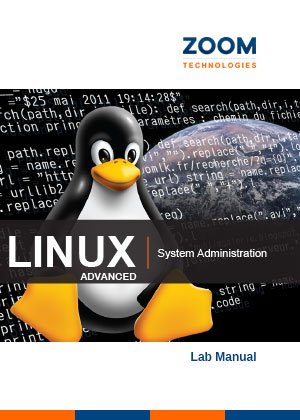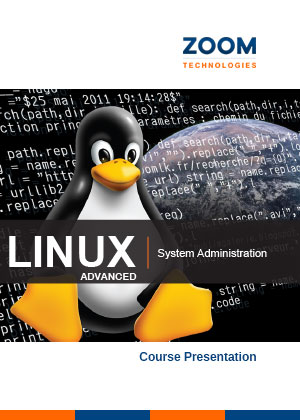Linux Professional Course details in PDF
Practical Implementation in Real Time Environment
Zoom Technologies brings to you the all new Advanced Linux course. This course is designed for professionals to easily install and configure advanced Linux services like IPv6, IPsec VPN, iptables as well as configuration of SAN, MySQL etc. The training will be conducted by senior System / Network engineers with several years of industry experience.
Brief Overview:
- Introduction and configuration of LDAP Server
- Configuration of Winbind Server
- Integration of Active Directory Users with Linux Clients
- Implementation of LDAP Backup Server
- Introduction & configuration of Postfix Mail Server
- Authentication of SAMBA DOMAIN Server with WINDOWS Clients
- Introduction & configuration of Kerberos Server
- Introduction & configuration of MySQL Database Server
- Implementation of HTTPS Service
- Implementation of Nagios Monitoring Tool Service
- Introduction & configuration of SAN
- Explanation & configuration of CLUSTER Servers
- Importance & configuration of NTP Server, Network Teaming and Rsyslog Server
- Introduction & configuration of VPN (IPSeC)
- Introduction & configuration of Apache Tomcat.
- Implementation of all Servers on IPv6 DNS, WEB & MAIL etc.,
- Securing Network with Firewall (IPtables, SElinux and FirewallD)
Booting Process
- Introduction to Booting Process
- Explaining types of booting process
- Kernel Initialization
- Types of Runlevels
- Changing Runlevels
- Managing services and daemons using systemctl command
Troubleshooting Linux System
- Recovering super user password
- Assigning password on GRUB
- Recovering GRUB password
- Troubleshooting server related issues
Virtualization
- Installing Virtual machines using QEMU hypervisor
- Starting and stopping libvirt daemon
- Creating clone on virtual operating system
Apache Web Server (HTTPS)
- Introduction of Apache
- Differences between HTTP And HTTPS
- Generating SSL keys
- Creating CA
- Redirecting http to https
- Configuring HTTPS Clients
Apache Tomcat Server
- Installation of JDK
- Installation and Configuration of Tomcat
- Creating tomcat user and password
- Access Tomcat with web Interface
- Deployment of Java files
Proxy Server (Squid)
- Introduction to proxy server
- Configuring proxy server and clients
- Creating squid ACL’s rules to control internet access
- Explanation about cache records
NTP Server
- Introduction of NTP server
- Configuration of NTP server
- Configuration of NTP and Chronyd Clients
- Verifying date and time synchronization
Advanced File Permissions
- Explanation of SUID, SGID and Sticky bit
- Configuring SUID on commands
- Configuring SGID on group users
- Configuring Sticky bit on objects
- Configuring different permissions on users/groups using ACL permissions policy
Links Configuration
- Explaining types of Links
- Creating soft links and hard links
- Differences between Soft and Hard links
Samba Server
- Introduction to samba server
- Configuring Samba server to share data with Linux and windows clients
- Configuring samba server for multiple users
SAMBA PDC (Primary Domain Controller)
- Configuring samba PDC server
- Creating samba password on root user
- Integrating windows client system into samba PDC server
- Creating users in samba PDC database
- Login Linux users into windows client systems
Samba Winbind Configuration
- Introduction to samba winbind
- Installing samba winbind
- Integrating Linux client system with Active Directory domain
- Starting winbind and oddjobd services
- Login Active Directory Users from Linux clients
Kerberos Server
- Introduction to Kerberos
- Kerberos server configuration
- Kerberos client configuration
- Creating certificates in Kerberos server and client systems
- Integrating Kerberos with NFS server
- Configuration of Kerberos clients
Remote Installation (PXE Server)
- Introduction to PXE and Kickstart
- Kickstart configuration
- PXE configuration at server system
- Installing an operating system in client systems
Backup and Recovery
- Introduction to dump command and backup methods
- Taking full backup, Incremental and Differential backup
- Explaining values of dump command
- Deleting an existing data
- Restoring lost data
Remote Backup
- Taking remote backup using scp command
- Finding data in destination system
- Restoring the data back
Automation of jobs
- Introduction to Crontab
- Scheduling the system task automatically
- Verifying the result
Openssh Configuration
- Introduction to Openssh
- Accessing the remote system using ssh command
- Creating ssh key using ssh-keygen
- Configuration of ssh authentication
- Making client login into other system without password
IPsec VPN
- Introduction to VPN
- Features of VPN
- Types of VPN
- Types of VPN Protocols
- Creating tunnel in between networks
- Configuration of host to host VPN
- Verifying result in client systems
Maria DB
- Installation of MariaDB on LINUX
- Starting the service
- Creating a MariaDB root Account
- Location of MariaDB Database
- Accessing MariaDB Command Line
- Creating and Deleting MariaDB
IPv6 Configuration
- Check For Ipv6 Support In The Current Running Kernel
- Compile kernel with IPv6 capabilities
- IPv6 network devices
- Adding, Checking and Removing IPv6 using nmcli command
- Bringing Interface up/down
- Configuring Servers on IPv6 address
LDAP Server
- Introduction of LDAP
- Structure of LDAP Schema
- Features of LDAP
- Differences between NIS and LDAP
- Configuring LDAP Server
- Configuring LDAP Client
- Adding, Modifying and Deleting Users from LDAP Database
Auto Mounting
- Introduction to Auto Mounting
- Auto Mounting to NFS shared directory
Kernel Up gradation
- Checking existing Kernel
- Upgrading Kernel with RPM tool
- Check new kernel version
Log Server
- Configuring Rsyslog and Saving Syslog Messages
- Sending Syslog Message over the network
- Configuring Rsyslog clients and Users log files
Mail Server (Postfix/Squirrelmail)
- Basics of Mail Servers
- Configuring SMTP service using Postfix
- Configuring POP3 / IMAP service on Linux
Storage Technologies (iSCSI SAN)
- Introduction to SAN, DAS and NAS
- Explaining components of SAN
- Configuring SAN Server by using targetcli
- Making SAN Clients by using iscsiadm tool
Logical Volume Manager (LVM)
- Introduction to LVM components
- Increasing and decreasing partition size
Disk Quotas
- Enabling Quotas on partitions
- Creating Quotas for users
- Auditing Quotas limit
Process Management
- Introduction to Various Process
- Managing Background and Foreground Process
- killing process
- Monitoring and Managing using top command
- Explanation of Nice values, Zombie and Orphan process
Network Teaming (IP Bonding)
- Introduction to Teaming
- Round Robin Runner
- Active Backup Runner
- Load Balancer Runner
- Configuring active backup Teaming
Clustering (Web Based)
- Types of CLUSTER
- Explanation of Load Balancing & LVS Components
- Configuring Real and Backup Servers
- Checking Load Balancing in CLUSTER Server
Nagios Monitoring Tool
- Installation of Nagios and Plugins
- Configuration of Nagios
- Creating Nagios User and Group
- Starting the Service
- Monitoring network infrastructure via Nagios web interface
- Adding hosts and services into Nagios database
IP-tables Firewall
- Introduction to IP-tables chains and tables
- Configuration of IP-tables rules
- Activating the IP-tables rules
- Configuring IP-tables to secure network
SElinux Firewall
- Introduction to SElinux policies
- Configuring SElinux Permanent
- Configuring SElinux to protect various servers
Dynamic Firewall
- Introduction to firewalld
- Difference between IP-tables and Dynamic Firewall
- Configuring rich rules
- Configuring port forwarding rule
- Adding firewalld rules permanent and temporary
- Updating the rules
Webmin Installation
- Introduction to webmin
- Installation of webmin
- Operating Linux on GUI mode






